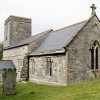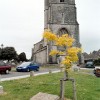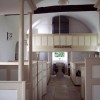Where better to start a day out at Abbotsbury than at the top of Abbotsbury Hill. From this vantage-point you can enjoy breath-taking views of the Dorset coastline, but to do so safely use one of the lay-bys provided. To the west you can see over Lyme Bay and it is said that on a fine day the view is clear to Start Point, off Plymouth. The view to the east is over The Fleet Lagoon with Chesil Beach stretching across the vista to the Island of Portland. In the foreground, sitting on a hill and from here easily mistaken as nothing more than a lookout point, is St. Catherine’s chapel. This is the first of many glimpses of the chapel you will enjoy during the day.
Before descending to the village cross over the road and take a walk around Abbotsbury Castle. This is an Iron Age hill-fort on the brow of Wears Hill on the edge of the hills to the north of Abbotsbury known as the Ridgeway. The hill-fort has double ramparts, which enclose an area of about 4 acres; the whole site covers about 10 acres. The fort is seven miles from Maiden Castle and five miles from the hillfort of Eggardon.
Down in the village you will find a choice of places offering food and drink. Tuck in and enjoy, forget the calorie count; there is still lots to see and places to visit, and any surplus energy you have you will need for the final climb of the day. In the village you are spoilt by a variety of shops offering all manner of interesting goods from the usual tourist bric-a-brac to some excellent work offered to you directly by local craftsmen and artists.
As you walk through the village feast your eyes on the cottages: many date back to the 16th century or earlier. Strict planning and conservation regulations ensure they remain much as they were.
The Church of St. Nicholas is well worth a visit. It is mainly 15th century, but was rebuilt in the 16th century and restored in 1885. There is a fine embattled tower with six bells. During the Civil War the church was defended for the King, and in the Jacobean pulpit there are two-bullet holes, evidence of the conflict.
Standing in the porch is an effigy in Purbeck marble, (actually a grave slab from the earlier Abbey church) of a late 12th century abbot. The 15th century stained-glasswork is a notable feature of this church and the panes in the north and south aisle windows are noted for their subtlety of colour. Of special interest is the second window in the south aisle which shows the delicate face of a woman thought by some to represent St. Catherine, but is more likely to be the Virgin Mary from a Crucifixion window.
A few steps through the churchyard will bring you to the site where the Abbey of St. Peter stood. From here there is another view of St. Catherine’s Chapel. Of the Abbey little remains to be seen: only one wall and the entrance arch remain standing. Sir Giles Strangeways bought the Abbey, its lands and holdings in the 16th century just four years after he had been the commissioner appointed by Henry VIII to negotiate the surrender of the monastery. A caveat on the sale to Sir Giles dictated that the Abbey was to be demolished and there is no doubting that the condition was honoured. English Heritage has placed an information board here and it includes an artist’s impression of how the Abbey would have looked before it was destroyed. You may think the destruction a terrible sacrilege.
A couple of hundred yards away we can see the Abbey Barn and this will be of great interest to any children who may be accompanying their parents. Nowadays it is home to a menagerie of friendly farm animals and many of these, including the goats, can be stroked and fed at regular times thoughout the day; ideal for under 11’s. Toy tractor racing and pony rides are to be enjoyed. And there is more to keep the children occupied: inside the ‘Smugglers Barn’ there is an undercover play area including an interactive educational play area on two floors inside the reconstructed hulls of a smugglers lugger and revenue cutter from the 18th century.
The Abbey Barn dates from the 14th century and being 272 feet in length is one of the largest barns in England. The timber and thatched roof is much later.
Abbotsbury is most famous for its swannery: it is just down the lane from the Abbey Barn. These amazing creatures freely choose to be here and in no way are they confined to the place. Surprisingly they will allow you to wander amongst them and you can see them at close quarters, nesting and looking after their young. The swannery is home to as many as 1000 birds.
Established in 1393 by the Benedictine monks at the Abbey it is a largely artificial pond on the land side shore of The Fleet Lagoon. It is likely the swans were here before the monks, attracted by the eel-grass that grows in the waters of The Fleet.
Time now to visit the Sub Tropical Gardens. Twenty acres of woodland valley with exotic plants from all over the world and a nursery where you can buy plants and seeds. The first Countess of Ilchester established the gardens in 1765 as a kitchen garden to her nearby residence. In 1990 considerable damage was caused by a severe storm but since then the gardens have been restored and many new exotic and unusual plants have been introduced. There are formal and informal gardens with woodland walks and walled gardens. There is a bird aviary, children’s play area, and a colonial teahouse: here you can rest you feet for a few minutes before moving on to climb up to St. Catherine’s Chapel.
We started our day out at the top of a hill so it is appropriate to end it the same way. Throughout our stay at Abbotsbury we have been able to see St. Catherine’s Chapel from nearly every place we have visited: now it is time to take a closer look. The chapel is at the top of a grassy hill, some 250 feet above and 700 or so yards from the church; and quite a steep gradient to climb.
Built around the end of the 14th century the chapel’s survival intact after the actions of Henry VIII in 1538 possibly had something to do with it being a useful navigation marker for seafarers. From outside the thick walls and huge buttresses give the impression of a larger structure but internally the chapel is only 45’ x 15’. The chapel’s dedication is to the patron saint of spinsters and there is a notice inside, which says that once a year a spinster can pray to St. Catherine.
From the chapel you can look landward over the church, the Abbey Barn and the picturesque and historic village, seaward over The Fleet Lagoon; the Swannery, the Sub Tropical Gardens and Chesil beach where you could sit awhile in the warm early evening sun and watch the waves breaking against the shore and think “oh, what a perfect day.”



